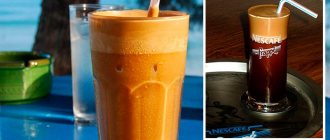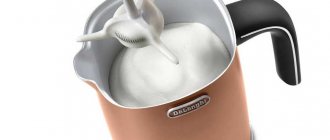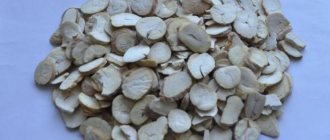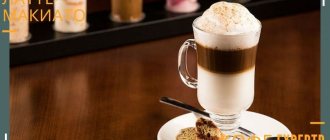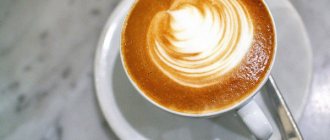Are you familiar with cold brew coffee? No, it's not espresso with ice, milk, syrup and whipped cream. This is black coffee prepared with cold water.
Why is he interesting? Firstly, on hot summer days it can be a good alternative to hot coffee drinks. Second, cold-extracted coffee tends to have a higher sweetness and body, which may appeal to many people.
Among other significant advantages, this brewing method allows you to extract flavoring and aromatic compounds that cannot be extracted at high temperatures. Cold brew also contains no oils and fatty acids (esters, ketones, amides), which add bitterness to your favorite drink. In addition, cold brew is the most environmentally friendly cooking method, because it does not require any extra electricity or gas. Having said that, making cold brew is a fairly simple process, and we’re pretty sure that after reading this article you’ll definitely have some in your refrigerator.
What is cold brew
Cold brew (from English cold brew) is black coffee brewed with cold water. It is distinguished from other methods of preparation by its unusually long brewing time - from 8 to 24 hours. The result is a refreshing and very tonic drink with low acidity and bitterness, high sweetness. Its concentration will depend on your wishes: you can make a light drink, similar in density to a pour-over, or you can brew a concentrate to dilute it with water, milk or add ice.
Cold brew is not a new invention. It is believed that this method of preparing coffee was used back in the 17th century by Dutch merchants transporting goods from Asia over long distances: cold brewing allowed them to prepare a drink that could be stored for a long time and drunk cold or hot. From Holland, this method penetrated to Japan, where it became incredibly popular.
In the late 1960s, Japanese entrepreneur Uyoshima Tadao began producing iced coffee in cans. The idea was picked up by various manufacturers, from local to large ones, such as Illy. Coffee in cans can still be found in stores today, and during the summer season many coffee shops offer their own versions of cold brew and drinks based on it in bottles that are convenient to take with you and store in the refrigerator.
In addition, in the 1960s, another invention related to cold brew appeared: American Todd Simpson, a plant nursery owner and chemical engineering specialist, went on an expedition to Guatemala and Peru, where he first tried cold brew coffee, which was served warm. The drink was amazingly smooth and tasty, and Todd decided to try making something similar himself. This is how a device called Toddy appeared with a complex filtration system that makes it easy to prepare cold brew both at home and in industrial settings.
What is cold brew?
Cold brew is not a cocktail or a coffee-containing drink, but real coffee prepared using a special technology. Unlike the usual espresso or Turkish coffee, cold brew is prepared using cold water. The cooking method also differs. This is not the usual heating, but infusion.
The name “cold brew” refers to the method of preparation. Translated from English as “cold brew”.
The recipe gained worldwide popularity several years ago, however, it has been well known for more than half a century.
- Some attribute the authorship to the Dutch. From Holland the idea spread to Japan. Residents of the Land of the Rising Sun have, indeed, been making and selling cold canned coffee for many years in a row.
- Some researchers believe that the technology was invented by Todd Simpson, a genetic engineer. He began infusing ground coffee in cold water during his expedition to Latin America. After the scientist returned, the idea found technical embodiment in the form of a machine for preparing cold brew. Modern devices for preparing cold brew operate based on the Simpson method.
These two versions are the most popular, but who can guarantee that no one else came up with the idea of infusing coffee in cold water much earlier?
Whoever was the author of the invention, it received a second birth after 2002, when there was a surge of interest in high-quality coffee and unique recipes in the global coffee industry. Experts call this period the “third coffee wave,” during which many recipes and technologies, including cold brew, were rethought.
Today, manufacturers of coffee equipment are actively producing devices for preparing cold brew at home and in a coffee shop. For example, the Brewista system allows you to get about 23 liters of cold brew coffee at once, which is very convenient for coffee shops or bars.
Cold brew and cold drip: what's the difference?
Typically, cold brew refers to an immersion method of brewing coffee: ground beans are immersed in water and remain in it throughout the entire brewing process. In this way, you can prepare coffee in a regular cup or jar, or you can use devices in which coffee can be both brewed and filtered: a French press, Aeropress, immersion funnels, or the Toddy system, which was mentioned above. Cold brew brewed using the immersion method will be less acidic than coffee brewed with hot water because not all of the acids can be extracted in the cold water. At the same time, the taste will have a lot of caramel sweetness, since the water will have time to extract a lot of sugars from the coffee bean.
Cold Drip is a method of cold brewing, also known as “Kyoto” or “Dutch”. Essentially, this is the same pour-over, but the brewing process in it is very slow and takes up to 24 hours. The taste of coffee is more “terroir”, fruity or floral shades will be more pronounced in it, since less sugars are extracted than with the immersion method. Cold drip is a more complex method that requires special equipment. Typically this is a design of three tanks: the top one is for cold water, the middle one is for ground coffee and the bottom one is for the finished drink.
Cold brew: taste and features
Coffee differs from the recipes we are used to not only in its original preparation method, but also in its taste characteristics. Cold extraction releases large amounts of caffeine and relatively small amounts of chlorogenic acid and tannins into the infusion. Therefore, cold brew has a mild and pleasant taste. There is almost no sourness in it, and the usual coffee bitterness is felt much weaker. But don’t let the subtle bouquet of cold brew fool you – the drink contains more caffeine than espresso – from 150 mg of caffeine per 100 ml of liquid.
Main characteristics of cold brew
- Mild taste without sourness and minimal bitterness.
- High caffeine content.
- Subtle aroma.
- Good combinability with other ingredients: milk, juices, syrups.
Extraction time
At room temperature, extraction occurs faster than in the refrigerator, but in any case, the clock counts. The optimal brewing time for cold brew is 12-18 hours; the longer the coffee is brewed, the richer it will be. Focus on your taste: if the drink seems insufficiently rich and lacks sweetness, you can leave it to brew for two to three hours longer.
Because cold brew takes time to brew, it can take days to find the perfect recipe. To find “that same taste” faster, it is better to brew several drinks at once - in different devices, with different grains, with different dosages, with or without hot pre-wetting, for different times... Then the very next day you will be able to compare different options and choose the one you like. Happy experimenting!
Difficulties of cooking
Brewing delicious coffee using the cold method is not so easy. First you need to choose good raw materials. This requirement can be applied to all methods of preparation, but when the coffee powder is boiled, brewed or steamed, the shortcomings in taste are slightly leveled out. There are no high temperatures here, so the quality of the coffee beans plays a paramount role. For a classic drink, only 100% Arabica is suitable.
The taste of water is very important. Filtered water will do, but the best option would be boiled and then cooled water.
The cold infusion process is very long, which can take from 8 to 24 hours. In a specialized coffee maker, the drink is prepared within 3 - 6 hours.
How to serve and drink
Cold brew coffee is served in glass glasses and consumed neat or diluted (with water, milk, cream or fruit juices). If desired, you can add a few ice cubes to it.
If sugar was not added at the cooking stage, it will be difficult to do so later. In this case, it is better to add syrup or liqueur. A good addition would be fruits, berry desserts, whipped cream, condensed milk or ice cream. A great flavor combination is iced coffee with cherry juice or coconut milk. A drink with orange juice and lemon syrup can be an invigorating option in the morning. Coffee sour has an interesting taste - a mixture of cold brew and pomegranate juice.
Due to the high caffeine content, you can drink the drink in its pure form no more than 2 - 3 servings per day.
How to make cold brew at home
Ingredients:
- bean coffee (100% Arabica);
- coffee grinder;
- pure water;
- spoon;
- French press or any glass container of suitable volume.
Dosage of ingredients
The choice of the amount of ingredients for cold brew depends on how strong you plan to get it:
- For a drink that can be consumed without diluting, take 10 grams of ground coffee per 100 ml of water.
- To get a very rich coffee (you can drink it straight away or, if desired, dilute it) - 15 grams of crushed beans per 100 ml of water.
- From 20 - 25 grams of ground coffee per 100 ml of water, a drink is obtained - a concentrate.
For cold infusion, medium-ground coffee is better suited, because the drink should not contain grounds, and small particles are difficult to get rid of. The coarser the grind, the longer it takes to infuse.
Cooking technology
- Grind the coffee (you can use ready-ground coffee).
- Pour the ground beans into the bottom of a French press (or other container) and fill it with water. It can be either chilled or room temperature.
- Mix the ingredients thoroughly.
- Close the vessel and let the drink brew for 12 - 24 hours. There is debate about how best to brew: in the refrigerator or at room conditions. Obviously, at a temperature of 20 - 25 degrees the process will go faster. If you place the container in the refrigerator, you will have to steep it for at least a day, but many people like this type of coffee better.
- Once brewing is complete, lower the plunger of the French press to the grounds, but do not press on them. If brewing was in another container, then you need to pass the product through a sieve.
- To remove any remaining grains, strain the drink through a dampened paper filter or muslin cloth. Repeat the procedure 2 - 3 times until the liquid is cleared of all visible particles.
The finished product can be stored in the refrigerator for 1-2 weeks.
Many manufacturers of household appliances have launched devices that help prepare coffee using the cold-drip method at home. Their use simplifies the process somewhat, and its duration is reduced several times.
What is the difference between cold brew and soft coffee drinks?
The most popular in this coffee genre are cold coffee and iced coffee. For those who cannot do without their favorite drink on hot summer days, they have become an excellent alternative to hot espresso.
They prepare iced coffee without further ado. First, it is brewed in a coffee machine, a Turk, or brewed in a French press. The drink must be highly concentrated, taking into account the fact that it will come into contact with melting ice. Cooled strong coffee is poured into a tall glass and cubed or crushed ice is added. Ice cubes reduce the concentration of the drink and do not allow it to warm up. The chilled natural product wonderfully refreshes and tones.
Ice coffee, prepared using the same technology, adds ice cream, syrups, cream, and milk. The result is a delicious and healthy cocktail that will delight you on a summer day. But a person devoted to the art of coffee will never give it preference if faced with a choice: iced coffee or cold blue? Of course cold brew!
Let's justify this choice:
- Prepared using long-term filtration, cold brew coffee captivates with its density and richness of taste.
- There is no bitterness or acidity in the drink, there is balance and harmony.
- The aroma of coffee beans is revealed in all its glory, without concealing its subtlety and sophistication.
- Prolonged contact of coffee with cold water greatly reduces its acidity, so this version of the drink is not contraindicated for people with stomach diseases.
- Thanks to the long extraction process, we get strong coffee that is no less invigorating than hot coffee.
- High-quality single-origin coffees reveal their advantages; water takes away all facets of taste and aroma from the beans.
It's time to find out the recipe for cold brew coffee. Let's prepare cold coffee for ourselves and our loved ones, even if the season is inappropriate. After all, the house is always warm.
About cooking methods
There are two main ways to prepare cold brew - the filtration method and long-term infusion.
Classic filtering
To prepare iced coffee this way, you will need special equipment. Todd Simpson, already familiar to us, received his coffee concentrate in a similar way. Devices designed to produce the drink have gone on sale.
Note: I asked about the cost of cold brew systems to save your time. Not cheap! I couldn’t find it cheaper than 3000 rubles. I have no doubt that the sets are of high quality. But wouldn't it be better to spend these thousands on buying good coffee?
It’s easy to make such a coffee maker with your own hands, even using improvised materials. You will need three containers installed one on top of the other. The topmost container will contain cold water, the middle one will contain ground coffee, and the finished drink will begin to flow drop by drop into the lower container. The main difficulty is that the water from the upper bowl flows onto the coffee very slowly, drip-wise. It is advisable to place a paper filter under the coffee.
We take a plastic bottle as a vessel for water. We cut off the bottom and punch a hole in the lid. It would be nice to install it on an AeroPress, but this is also an expensive device. Let's use another plastic bottle of a slightly smaller diameter as a medium container for coffee, adapting it to a funnel or deep strainer from a kettle. We install this structure on the can and begin testing.
Info: The AeroPress is something like a large syringe. Coffee is poured into it, hot water is poured in, and with the help of a piston and the physical effort of the person who wants to enjoy the coffee, the water is forced through the ground beans. The result is hot filtered coffee.
The strength of cold brew depends on the degree of grinding and the amount of serving poured into a medium container. The finer the grind and the larger the product volume, the stronger the coffee. The best option is ground coarse or medium-coarse grains. Their portion should be twice as large as when brewing coffee using the “hot” method. Less is possible, the final amount is determined by individual taste and experience.
The duration of the preparation procedure is 4-5 hours.
Infusion
Not everyone has the patience and engineering savvy to create a homemade device. You have to fork out money to buy the system. And I really want a strange cold brew, especially in the summer. We'll go the other way! There is an incredibly simple way to prepare it by infusing it.
Take any convenient container (jar, jug, large cup, French press). Pour ground coffee into it at the rate of 8-10 grams per 100 ml, fill it with filtered water at room temperature and close the lid. Note the time - after 8-12, maximum 24 hours, the coffee is ready. The vessel can be immediately placed in the refrigerator, the infusion process proceeds effectively there. The drink must be strained before drinking.
The resulting infusion cannot be distinguished in taste from a filtered drink. But experts say that it still has a bitter taste. Cold brew from a special device is softer and more refined.
You can add tenderness and adjust the taste using additives. They are quite acceptable with summer iced coffee.

